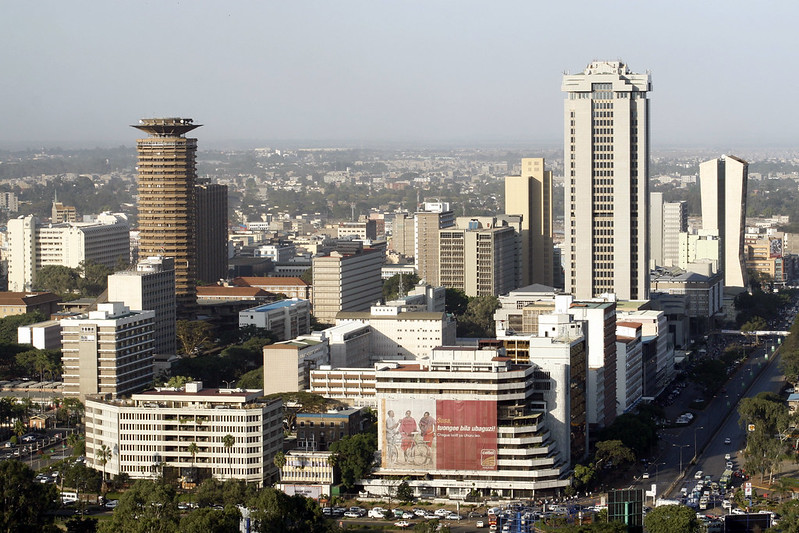Endangered Wildlife In Kenya — A Detailed Guide For (birds, Reptiles & mammals)
Kenya is famous for its beautiful savannahs, teeming wetlands, rare forest pockets, and its wildlife, which draws visitors and scientists from all over the world. Today, some of Kenya’s most iconic species are threatened or endangered.
This article explains which animals and birds are at risk, why they’re declining, what conservationists are doing, and how you can help.
Highlight: Current Situation And Recent Trends
- Several large mammals that were once in freefall — especially rhinos and elephants — have shown encouraging recovery in Kenya thanks to intensive protection, community-based conservation and translocations, but threats remain and populations are still vulnerable. (Sheldrick Wildlife Trust)
- Many forest-dependent and range-restricted birds remain endangered because of habitat loss and fragmentation — a problem that’s especially acute for species restricted to tiny mountain or coastal forest patches. (IFAW, BirdLife DataZone)
Mammals Of Particular Concern
Here’s a comprehensive reference table of Kenya’s endangered mammals, summarizing their population, range, main threats, and conservation measures:
| Mammal Species | IUCN Status | Population | Range / Habitat in Kenya | Main Threats | Conservation Measures |
|---|---|---|---|---|---|
| Hirola (Beatragus hunteri) | Critically Endangered | < 500 | Northeastern Kenya (Garissa, Ijara) | Habitat loss, poaching, predation, drought, and small population | Ishaqbini Hirola Conservancy, reintroduction programs, community engagement |
| Grevy’s Zebra (Equus grevyi) | Endangered | < 3,000 | Northern Kenya (Samburu, Isiolo, Laikipia) | Habitat loss, competition with livestock, poaching, and fragmented populations | Community conservancies, Grevy’s Zebra Trust monitoring, and anti-poaching patrols |
| Rothschild’s Giraffe (Giraffa camelopardalis rothschildi) | Endangered | < 2,000 | Lake Nakuru, Ruma NP, private conservancies | Habitat loss, poaching, and small, isolated populations | Arabuko-Sokoke Forest Reserve, community-based forest conservation, research, and monitoring |
| Mountain Reedbuck (Redunca fulvorufula) | Endangered | < 25,000 (scattered) | Highland areas: Aberdares, Mount Kenya slopes | Habitat loss, poaching, fragmentation, competition with livestock | Protected highland parks, anti-poaching patrols, and habitat management |
| Golden-rumped Elephant Shrew (Rhynchocyon chrysopygus) | Endangered | Unknown, very small | Coastal forests (Arabuko-Sokoke) | Habitat loss, forest degradation, predation, and a small range | Arabuko-Sokoke Forest Reserve, community-based forest conservation, research and monitoring |
| East African Oryx (Oryx beisa beisa) | Endangered | Few thousand | Northern and eastern Kenya (Samburu, Isiolo, Tsavo) | Poaching, habitat degradation, competition with livestock, and human encroachment | Protected areas and conservancies, anti-poaching, and community-based conservation |
| Tana River Mangabey (Chlorocebus galeritus) | Endangered | < 1,000 | Lower Tana River forests (southeastern Kenya) | Habitat loss, fragmentation, flooding, and human disturbance | Tana River Primate National Reserve, community forest management, habitat restoration |
| Tana River Red Colobus (Piliocolobus rufomitratus) | Critically Endangered | < 1,000 | Lower Tana River forests (southeastern Kenya) | Habitat destruction, fragmentation, and human disturbance | Tana River Primate National Reserve, forest restoration, community-based conservation |
This table provides a clear snapshot of Kenya’s endangered mammals, showing which species are most at risk, where they live, and what is being done to protect them.
Black And White Rino

Poaching for horns pushed black rhino numbers to the brink in the late 20th century. Intensive protection, captive breeding and rescue programs, and targeted translocations have led to steady population increases in recent years. Kenya has been actively moving rhinos to new conservancies to re-establish populations and relieve overcrowding in core parks. Despite gains, rhinos remain globally vulnerable, and every individual matters. (Sheldrick Wildlife Trust, AP News)
African Elephant
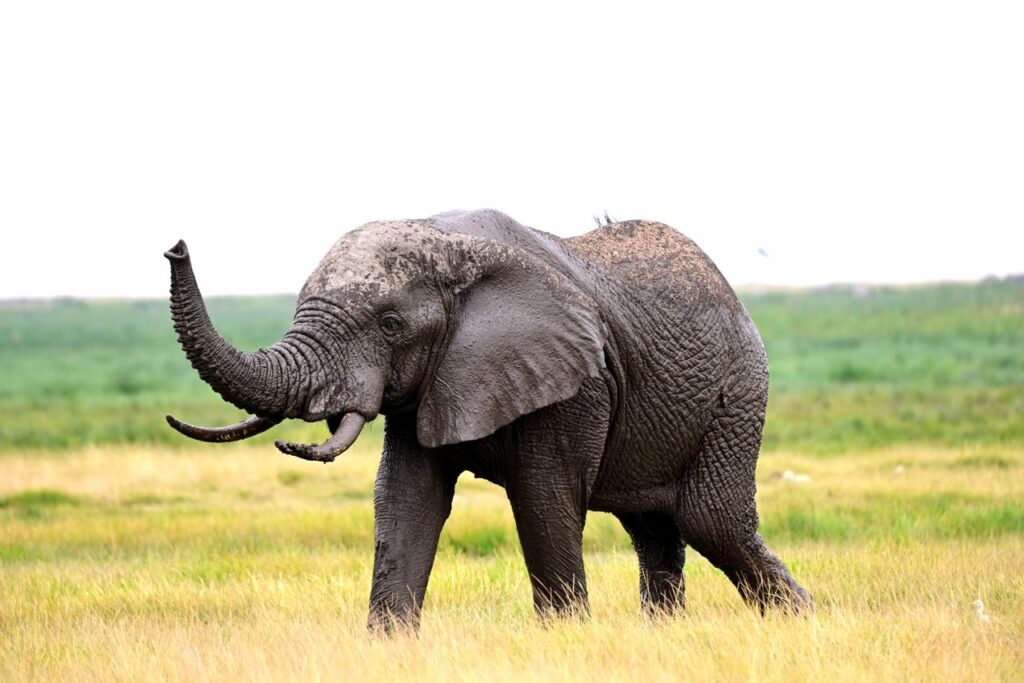
Elephants declined massively from heavy ivory poaching decades ago; national plans now focus on landscape-level management, anti-poaching, and conflict mitigation. In some areas, population recovery has created new management challenges (overcrowding, human–elephant conflict), requiring relocations and corridor restoration to link habitats. Kenya’s National Elephant Action Plan (2023–2032) guides these efforts. (Mara Elephant Project, Reuters)
Big cats: lion, cheetah, leopard
Lions and cheetahs in Kenya face habitat loss, prey depletion, and retaliatory killing when livestock are taken. Cheetahs are especially sensitive because they require large areas and often occur in human-dominated landscapes; lions have experienced severe regional declines over decades. Conservation focuses on protected-area management, community livestock-protection schemes, and landscape connectivity to reduce conflicts and preserve the prey base. (LifeGate)
African wild dog (painted dog)

Wild dogs are rare and fragmented across Kenya. Their complex social structure and wide-ranging behavior make them vulnerable to habitat fragmentation, disease from domestic dogs, and retaliatory killing. Long-term conservation needs secure, connected wildlands and disease management. (LifeGate)
Rothschild’s Giraffe (Nubian giraffe, Giraffa camelopardalis rothschildi)
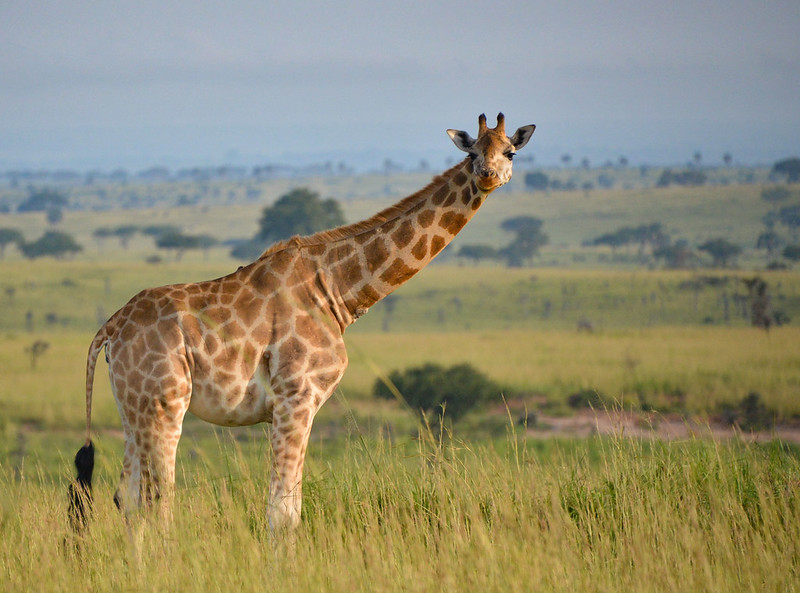
The Rothschild’s giraffe is one of the most iconic and rare giraffe subspecies in Africa, easily recognized by its striking coat pattern — light patches with less-defined edges and creamy-colored legs that appear almost “white stockings.” It is also one of the tallest giraffes, with males reaching up to 6 meters (19 feet).
Range And Habitat
Historically, Rothschild’s giraffes roamed widely across Kenya, Uganda, and parts of Sudan. Today, their natural range is much smaller. In Kenya, they are mainly found in protected areas such as Lake Nakuru National Park, Ruma National Park, and private conservancies. They prefer savannahs, open woodlands, and areas with acacia trees, which provide their main food.
Why Rothschild’s Giraffe is Endangered
The International Union for Conservation of Nature (IUCN) lists Rothschild’s giraffe as endangered, with fewer than 2,000 individuals left in the wild. Their decline is due to:
- Habitat loss and fragmentation – expansion of agriculture, human settlements, and infrastructure has reduced and broken up their range.
- Poaching – though less targeted today, giraffes have been hunted for meat, skins, and tails.
- Human–wildlife conflict – in farming areas, giraffes sometimes face hostility from communities competing for land and resources.
- Small, isolated populations – this increases vulnerability to disease, reduces genetic diversity, and makes them more at risk of local extinction.
Conservation Efforts
Kenya has played a leading role in protecting Rothschild’s giraffes through:
- Translocations: moving giraffes into safe areas like Lake Nakuru and Ruma National Parks.
- Community conservancies: supporting local people to benefit from eco-tourism while safeguarding giraffe habitats.
- Research and monitoring: collaring and studying giraffes to better understand their movements and needs.
- International awareness campaigns: raising the giraffe’s profile has helped secure funding and global support.
In summary, the Rothschild’s giraffe is an endangered subspecies with a restricted range in Kenya and Uganda. While conservation efforts have helped stabilize numbers in some areas, habitat loss and fragmentation continue to threaten its survival, making ongoing protection and community involvement essential.
Reticulated Graffe (Giraffa camelopardalis reticulata)

The Reticulated giraffe is one of the most beautiful giraffe subspecies, easily recognized by its distinctive coat: large, polygon-shaped chestnut patches separated by thin white lines, giving it a “net-like” (reticulated) pattern.
Range and Habitat
This giraffe occurs mainly in northern Kenya, particularly in regions like Samburu, Isiolo, Wajir, and Garissa, as well as community conservancies such as Samburu National Reserve and Buffalo Springs. It favors dry savannahs, open woodlands, and semi-arid scrublands, where it browses on acacia leaves and other shrubs.
Conservation Status
The Reticulated giraffe is classified as Endangered by the IUCN, with wild populations estimated at around 16,000 individuals. Numbers have declined by more than 50% over the last few decades.
Main Threats
- Habitat loss – due to settlement, farming, and infrastructure projects.
- Poaching – for bushmeat and hides, especially in unprotected areas.
- Human–wildlife conflict – competition with livestock for food and water in arid rangelands.
- Fragmentation – isolated populations reduce genetic diversity and make them vulnerable to local extinction.
Conservation Efforts
- Community conservancies in northern Kenya (e.g., in Samburu and Laikipia) protect giraffes while providing locals with eco-tourism benefits.
- Monitoring and research programs (e.g., the Giraffe Conservation Foundation) track populations and support anti-poaching efforts.
- Awareness campaigns have raised the giraffe’s profile, helping to mobilize funding and international support.
In summary, the Reticulated giraffe is an endangered subspecies found mainly in northern Kenya. With its strikingly patterned coat, it is one of the most recognizable giraffes, but it faces serious threats from poaching and habitat loss. Ongoing conservation programs, especially community-led efforts, are key to its survival.
Hirola (Beatragus hunteri)

The Hirola, also called the Hunter’s hartebeest or four-eyed antelope (because of the large pre-orbital glands below its eyes), is one of the rarest antelopes in the world and is found only in northeastern Kenya, along the border with Somalia.
Appearance
- Medium-sized antelope with a slender build.
- Sandy-brown coat that turns darker with age.
- Distinctive white facial markings and the “double eye” appearance.
- Both males and females have ridged, lyre-shaped horns.
Conservation Status
The Hirola is classified as Critically Endangered by the IUCN. Fewer than 500 individuals are believed to survive in the wild today, making it Africa’s most threatened antelope.
Main Threats
- Habitat loss and degradation – overgrazing by livestock and bush encroachment reduce the grasslands the Hirola depend.
- Poaching, though less widespread today, hunting for meat historically reduced numbers.
- Predation pressure – small, fragmented populations are highly vulnerable to predators.
- Drought and climate change – dry conditions in its semi-arid range worsen survival challenges.
- Lack of genetic diversity – tiny populations mean greater risk of inbreeding.
Conservation Efforts
- Ishaqbini Hirola Conservancy (Garissa County, Kenya): a community-led conservancy providing safe habitat, predator control, and grassland management.
- Hirola reintroduction programs: efforts to breed and expand populations in secure areas.
- Community engagement: local Somali pastoralist communities play a central role in protecting the species.
In summary, the Hirola is a critically endangered antelope found only in northeastern Kenya. With fewer than 500 left in the wild, it is sometimes called the “world’s rarest antelope.” Community-driven conservation in areas like Ishaqbini offers the best hope for saving this unique species.
Grevy’s Zebra (Equus grevyi)

The Grevy’s zebra is the largest and most endangered zebra species. Unlike the more common plains zebra, it has narrow black-and-white stripes that don’t extend onto the belly (which is white), large, rounded ears, and a mule-like appearance.
Range and Habitat
Grevy’s zebras are mainly found in northern Kenya (Isiolo, Samburu, Laikipia, and Marsabit) with a small population in southern Ethiopia. They prefer semi-arid grasslands and shrublands, often close to water sources.
Conservation Status
- Listed as Endangered by the IUCN.
- Fewer than 3,000 individuals remain in the wild, with over 90% of the population in Kenya.
Main Threats
- Habitat loss and degradation – overgrazing by livestock reduces grass availability.
- Competition for water – pastoralist herds often outcompete zebras during dry seasons.
- Hunting and poaching – historically for skins, but now mostly for bushmeat.
- Fragmented populations – small, isolated groups are more vulnerable to drought and disease.
- Climate change – prolonged droughts affect water and forage.
Conservation Efforts
- Community conservancies in northern Kenya (e.g., in Samburu and Laikipia) protect habitat and reduce human–wildlife conflict.
- Grevy’s Zebra Trust (GZT): conducts monitoring, community engagement, and education programs to promote coexistence.
- National and international support: Kenya holds the stronghold population, making local conservation critical to global survival.
In summary, the Grevy’s zebra is an endangered species with most of its remaining population in northern Kenya. Its survival depends heavily on community-based conservation, sustainable grazing practices, and protecting critical habitats in semi-arid rangelands.
Tana River Mangabey (Chlorocebus galeritus)
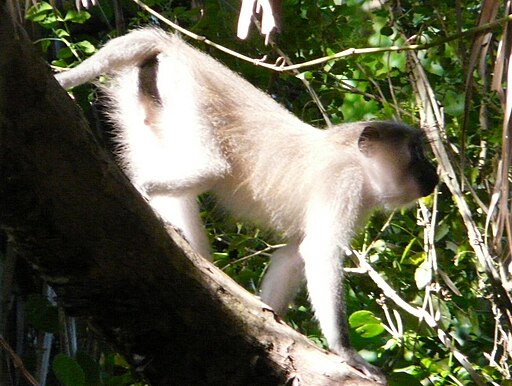
The Tana River mangabey is a rare, medium-sized monkey found only in Kenya, making it an endemic primate species. It is distinguished by its long golden-brown fur, dark face, and a distinctive crest of hair on the head.
Range and Habitat
- Restricted to gallery forests along the lower Tana River in southeastern Kenya.
- Lives in small, fragmented patches of forest, which are surrounded by farmland and grassland.
Conservation Status
- Classified as Endangered by the IUCN.
- The population is estimated at fewer than 1,000 and is declining.
- Highly vulnerable because of its tiny, fragmented range.
Main Threats
- Habitat loss – clearing of forests for agriculture, settlements, and fuelwood.
- Fragmentation – small isolated forest patches limit movement and genetic exchange.
- Flooding and climate change – natural disasters along the Tana River reduce forest cover.
- Human disturbance – logging and encroachment further shrink their habitat.
Conservation Efforts
- Tana River Primate National Reserve was established to protect the mangabey and the endangered Tana River red colobus.
- Community-based conservation projects aim to balance local livelihoods with habitat protection.
- Research and habitat restoration projects focus on reforesting degraded areas and maintaining forest corridors.
In summary: The Tana River mangabey is a unique, endangered primate found only in Kenya’s Tana River forests. Its survival depends on protecting and restoring these fragile riverine forests and involving local communities in conservation.
Tana River Red Colobus (Piliocolobus rufomitratus)

The Tana River red colobus is a rare primate found only in Kenya, making it endemic to the country. It is easily recognized by its reddish-brown cap, long tail, and black face framed with white hair. Like other colobus monkeys, it has a specialized stomach for digesting leaves.
Range and Habitat
- Restricted to riverine forests along the lower Tana River in southeastern Kenya.
- Shares its habitat with the Tana River mangabey, another endangered primate.
Conservation Status
- Listed as Critically Endangered by the IUCN.
- Fewer than 1,000 individuals remain, living in scattered forest fragments.
- It is one of the world’s rarest primates.
Main Threats
- Habitat destruction – clearance of riverine forest for farming, fuelwood, and settlements.
- Forest fragmentation – small isolated groups suffer from inbreeding and reduced resilience.
- Flooding and climate change – natural events along the Tana River further damage its limited habitat.
- Human disturbance – frequent logging and agricultural expansion reduce feeding areas.
Conservation Efforts
- Protected within the Tana River Primate National Reserve, though enforcement and forest protection remain challenging.
- Community conservation programs encourage local people to preserve forests while benefiting from eco-tourism and sustainable land use.
- Research and habitat restoration aim to connect fragmented forests and protect remaining patches.
In summary: The Tana River red colobus is a critically endangered primate found only in Kenya, with fewer than 1,000 left in the wild. Its survival depends entirely on protecting and restoring the fragile Tana River forests it inhabits.
Mountain Reedbuck (Redunca fulvorufula)
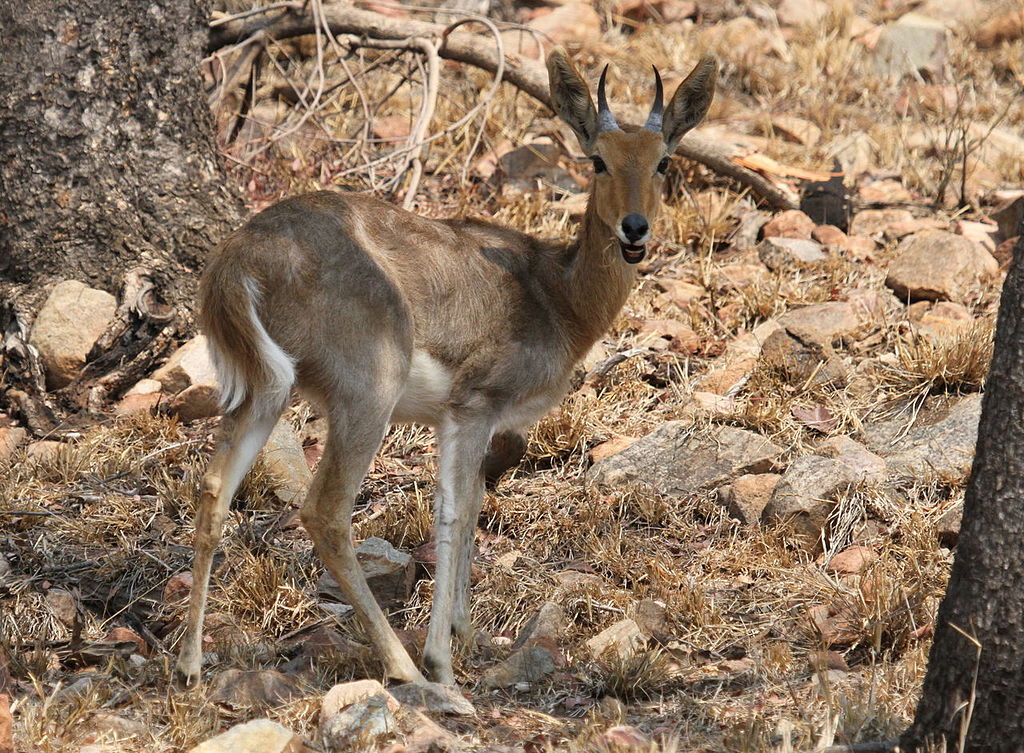
The Mountain reedbuck is a shy and graceful antelope that lives in rocky hillsides, escarpments, and grass-covered mountain slopes. It has a grey-brown coat with a reddish tinge, a white belly, and curved, ridged horns in males.
Range and Habitat
- Found in small, scattered populations across eastern and southern Africa.
- In Kenya, it occurs in highland areas such as the Aberdares, Mount Kenya slopes, and other rugged ranges.
- Prefers steep, rocky terrain with grass cover for grazing and shelter.
Conservation Status
- Classified as Endangered by the IUCN.
- The total population is estimated at fewer than 25,000 individuals, fragmented into isolated groups.
- In Kenya, populations are small and vulnerable.
Main Threats
- Habitat loss – caused by human settlement, farming, and overgrazing by livestock in mountain rangelands.
- Poaching – hunted for bushmeat in some areas.
- Fragmentation – small, isolated populations are at greater risk of decline.
- Competition – livestock often compete for grazing resources in their habitats.
Conservation Efforts
- Populations survive in protected areas such as Aberdare National Park and Mount Kenya National Park.
- Anti-poaching patrols and improved community awareness aim to reduce illegal hunting.
- Habitat protection through national parks and conservancies offers the best chance for survival.
In summary, the Mountain reedbuck is an endangered antelope living in Kenya’s highland ranges and rocky hills. Its small, fragmented populations are threatened by habitat loss and poaching, but protection in mountain parks gives hope for its continued survival.
Golden-rumped Elephant Shrew (Rhynchocyon chrysopygus)
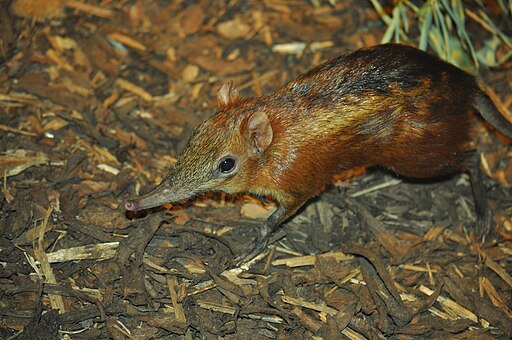
The Golden-rumped elephant shrew is a small, insect-eating mammal found only in Kenya, making it endemic to the country. It is the largest of all elephant shrew species and is instantly recognizable by its golden patch of fur on the rump, contrasting with its otherwise dark brown coat.
Range and Habitat
- Found exclusively in the coastal forests of Kenya, particularly in the Arabuko-Sokoke Forest and a few nearby forest patches.
- Prefers dense undergrowth in mixed forests where it forages for insects, spiders, and other invertebrates.
Conservation Status
- Classified as Endangered by the IUCN.
- Restricted distribution and specialized habitat make it highly vulnerable.
Main Threats
- Habitat loss and fragmentation – coastal forests are cleared for farming, logging, and settlements.
- Predation – by domestic dogs and cats near villages.
- Small range – being confined to one region increases the risk of extinction.
- Forest degradation – the removal of understory vegetation directly reduces food and shelter.
Conservation Efforts
- Protected within the Arabuko-Sokoke Forest Reserve.
- Community-based forest conservation programs aim to balance local livelihoods with wildlife protection.
- Research and monitoring by conservation groups help track populations and threats.
In summary, the Golden-rumped elephant shrew is an endangered small mammal found only in Kenya’s coastal forests. With its striking golden rump and limited range, it is one of the country’s most unique species, and its survival depends on protecting and restoring coastal forest habitats.
East African Oryx (Oryx beisa beisa)
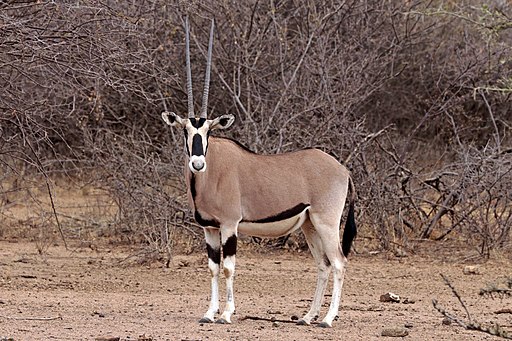
The East African oryx, also known as the Beisa oryx, is a striking antelope adapted to life in hot, arid savannahs and semi-deserts. It has a pale gray coat, a black stripe along its flanks and face, and long, straight horns found in both males and females.
Range and Habitat
- Found in northern and eastern Kenya, as well as parts of Ethiopia, Somalia, and Tanzania.
- Prefers dry bushlands, savannahs, and semi-desert plains, where it can survive with little water by obtaining moisture from plants.
Conservation Status
- Listed as Endangered by the IUCN.
- Wild populations have declined significantly due to habitat loss and hunting.
- Kenya remains a stronghold for the species, especially in Samburu, Isiolo, and Tsavo regions, and in community conservancies.
Main Threats
- Poaching and hunting – for meat, hides, and horns.
- Habitat degradation – overgrazing by livestock reduces forage.
- Competition with livestock – especially in arid rangelands.
- Human encroachment – expansion of settlements and agriculture.
Conservation Efforts
- Protected populations exist in national reserves and conservancies in northern Kenya.
- Community-based conservation programs help reduce poaching and promote eco-tourism.
- Anti-poaching patrols and habitat management are ongoing to secure remaining populations.
In summary, the East African oryx is an endangered desert antelope adapted to arid lands, with most of its surviving populations in Kenya. Its future depends on continued protection through conservancies, anti-poaching efforts, and sustainable coexistence with pastoralist communities.
Endangered Birds In Kenya
Kenya’s avifauna is rich, but a handful of species are extremely vulnerable because they live only in tiny forest fragments or a few coastal patches.
Here’s a comprehensive reference table of Kenya’s endangered endemic birds, summarizing their population, habitat, main threats, and conservation measures:
| Bird Species | IUCN Status | Population | Habitat | Main Threats | Conservation Measures |
|---|---|---|---|---|---|
| Taita Apalis | Critically Endangered | < 400 mature individuals | Montane forests of Taita Hills | Habitat loss, fragmentation, and human disturbance | Forest reserves, reforestation, habitat restoration, community engagement |
| Taita Thrush | Endangered | < 1,000 mature individuals | Montane forest patches in Taita Hills | Habitat loss, fragmentation | Forest protection, habitat restoration, and monitoring |
| Sharpe’s Longclaw | Endangered | Few thousand | High-altitude montane grasslands | Habitat conversion to agriculture, overgrazing, and fire | Protected grasslands, sustainable grazing, and monitoring |
| Sokoke Scops-Owl | Endangered | A few hundred – 1,000 | Coastal forests (Arabuko-Sokoke) | Habitat loss, fragmentation | Forest protection, anti-degradation measures, and research |
| Clarke’s Weaver | Endangered | < 2,000 | Coastal forests, dense undergrowth | Habitat loss, fragmentation, and human disturbance | Arabuko-Sokoke Forest Reserve, community-based conservation, monitoring |
| Abbott’s Starling | Endangered | < 2,500 | Coastal forests (canopy layer) | Forest reserves, community-based management, research, and monitoring | Forest reserves, community-based management, research and monitoring |
This table provides a clear overview of Kenya’s most endangered endemic birds, showing where they live, how many remain, and what actions are being taken to save them.
Taita thrush (Turdus helleri)
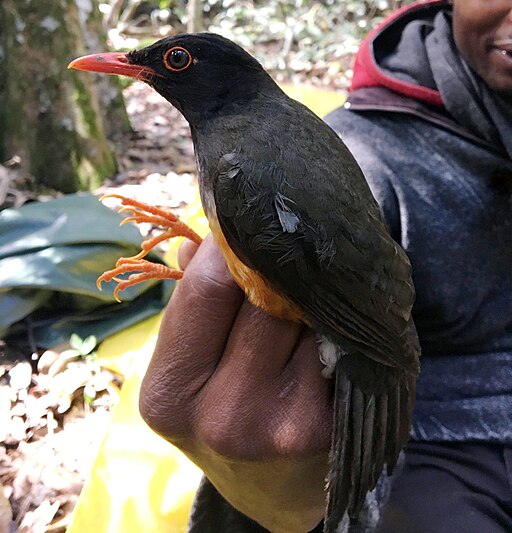
Endemic to the Taita Hills in southern Kenya, the Taita thrush occupies tiny, fragmented montane forest patches. Once classed as critically endangered, recent reassessments place it as endangered — but population estimates are still very small (fewer than ~1,000 mature individuals in recent reports), and the species is threatened by habitat loss and fragmentation. Protecting and restoring remnant forest fragments is vital. (IFAW, BirdLife DataZone)
Sokoke Scops-owl

This small owl is restricted to coastal Arabuko-Sokoke and a few coastal forest patches. Its range is tiny and fragmented; the species is listed as endangered because of its small area of occupancy and continuing habitat decline. Conservation of coastal forest patches and anti-degradation measures are essential for their survival. (peregrinefund.org, BirdLife DataZone)
Martial Eagle (Polemaetus bellicosus)
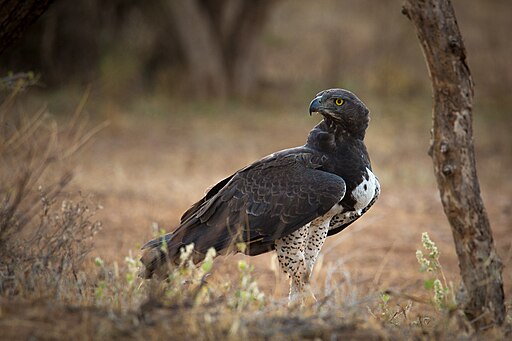
The Martial eagle is the largest eagle in Africa and one of the most powerful birds of prey in the world. It is known for its dark brown upperparts, heavily barred underparts, and striking yellow eyes. With a wingspan of up to 2.6 meters (8.5 feet), it dominates savannahs and open woodland habitats.
Martial eagle is a majestic and endangered raptor in Kenya, facing threats from habitat loss, persecution, and declining prey. Protecting large, undisturbed habitats and promoting coexistence with local communities are essential for its survival.
Range and Habitat
- Found across sub-Saharan Africa, including Kenya, mainly in savannahs, open woodlands, and hilly areas.
- Prefers areas with tall trees or cliffs for nesting and clear open spaces for hunting.
Conservation Status
- Classified as Endangered in some regions, with populations declining across much of its range.
- Threats are especially severe in East Africa, including Kenya, where habitat loss and human pressures are significant.
Main Threats
- Habitat loss and degradation – clearing of woodlands and savannahs for agriculture and settlements.
- Persecution – often killed by farmers who see them as a threat to livestock or poultry.
- Decline in prey availability – reduced populations of medium-sized mammals, birds, and reptiles affect food sources.
- Electrocution and collisions – on power lines or wind turbines in modified landscapes.
Conservation Efforts
- Protected areas such as national parks and conservancies provide safer nesting and hunting grounds.
- Community awareness programs aim to reduce persecution and educate about the ecological role of the species.
- Research and monitoring help track populations, nesting success, and threats to inform conservation strategies.
Sharpe’s Longclaw (Macronyx sharpei)
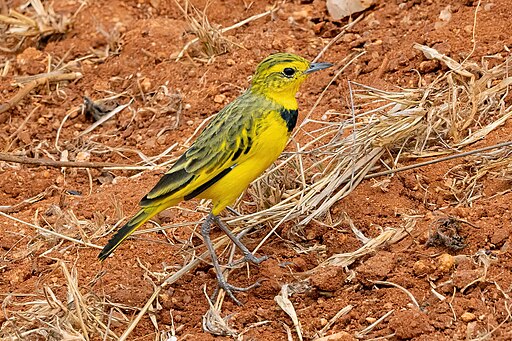
The Sharpe’s longclaw is a striking bird endemic to Kenya, belonging to the same family as larks. It is recognized by its bright yellow underparts, olive-brown upperparts, and a distinctive black breast band.
The Sharpe’s longclaw is an endangered bird endemic to Kenya’s highland grasslands. Its survival depends on protecting montane grassland habitats and managing human pressures like agriculture and livestock grazing.
Range and Habitat
- Found only in a few high-altitude grasslands in central Kenya, such as the Aberdare Ranges, Mount Kenya, and Kinangop Plateau.
- Prefers open montane grasslands, where it feeds on insects and seeds.
Conservation Status
- Listed as Endangered by the IUCN.
- The population is small and declining, with estimates of only a few thousand individuals remaining.
Main Threats
- Habitat loss and fragmentation – conversion of montane grasslands into agriculture and settlements.
- Overgrazing by livestock reduces food availability and nesting sites.
- Fire and land management practices – uncontrolled burning can destroy nests and feeding areas.
Conservation Efforts
- Protection of highland grasslands in national parks and forest reserves.
- Research and monitoring by bird conservation groups to track population trends.
- Promotion of sustainable grazing and land-use practices by local communities.
Taita Apalis (Apalis fuscigularis)

The Taita apalis is a small, colorful songbird endemic to Kenya, found only in the Taita Hills of southeastern Kenya. It is recognized by its olive-green upperparts, pale underparts, and subtle dark throat markings.
Taita-apalis is a critically endangered bird endemic to Kenya’s Taita Hills. With only a few hundred individuals left, protecting its montane forest habitat and connecting fragmented patches is essential for its survival.
Range and Habitat
- Restricted to montane forest fragments in the Taita Hills, such as the Mbololo, Ngangao, and Chawia forests.
- Prefers dense forest understory, feeding on insects and small invertebrates.
Conservation Status
- Classified as Critically Endangered by the IUCN.
- The population is extremely small, estimated at fewer than 400 mature individuals.
- Habitat fragmentation makes it highly vulnerable to extinction.
Main Threats
- Habitat loss and fragmentation – deforestation for agriculture, logging, and settlement.
- Small population size – limited range and isolated forest patches increase inbreeding risk.
- Human disturbance – forest degradation from livestock grazing and firewood collection.
Conservation Efforts
- Forest reserves in the Taita Hills provide partial protection for remaining populations.
- Reforestation and habitat restoration projects help reconnect fragmented forests.
- Community engagement encourages sustainable land use to protect the birds’ habitat.
Clarke’s Weaver (Ploceus golandi)
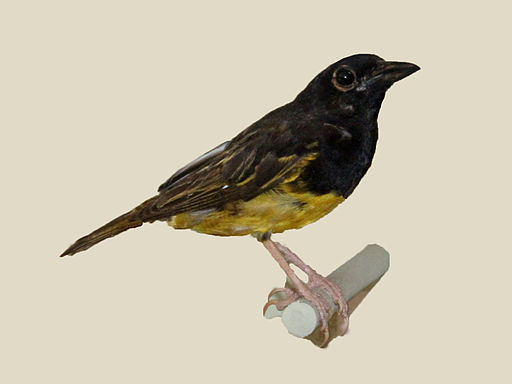
Clarke’s weaver is a small, brightly colored bird endemic to Kenya, notable for its yellow plumage with darker wings and a stout conical bill, typical of weavers.
Clarke’s weaver is an endangered bird endemic to Kenya’s coastal forests. Its survival depends on protecting and restoring remaining forest habitats and supporting sustainable community-led conservation initiatives.
Range and Habitat
- Found only in the coastal forests of southeastern Kenya, particularly the Arabuko-Sokoke Forest and surrounding woodland patches.
- Prefers dense undergrowth and forest edges, feeding on insects, seeds, and small fruits.
Conservation Status
- Classified as Endangered by the IUCN.
- The population is small and declining, with fewer than 2,000 individuals remaining.
- Highly vulnerable due to its restricted range and habitat fragmentation.
Main Threats
- Habitat loss – clearing of coastal forests for agriculture, settlements, and logging.
- Forest fragmentation – reduces nesting and feeding areas.
- Human disturbance – illegal logging and collection of firewood degrade habitat quality.
Conservation Efforts
- Protected within the Arabuko-Sokoke Forest Reserve, one of the last remaining strongholds.
- Community-based conservation programs encourage sustainable forest use.
- Research and monitoring help track population trends and inform habitat management.
Abbott’s Starling (Poeoptera femoralis)
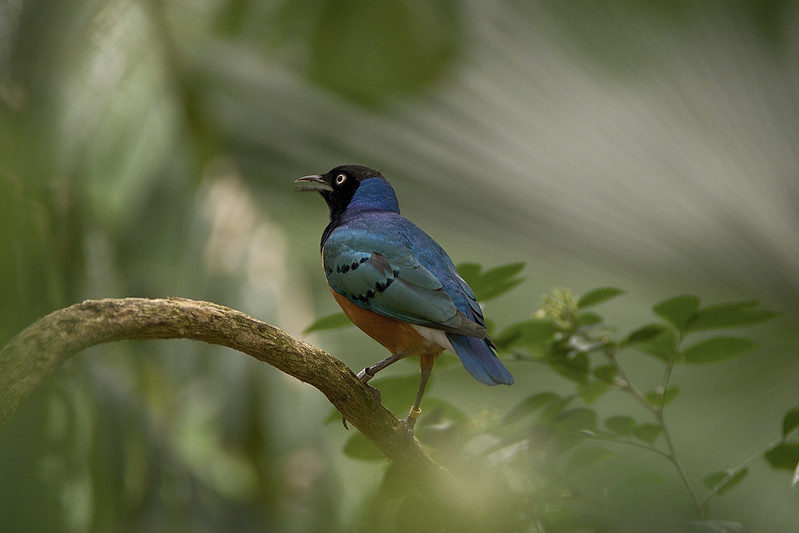
Abbott’s starling is a medium-sized, striking bird endemic to Kenya, recognized by its shiny black plumage with iridescent green and purple highlights, bright yellow eyes, and a short tail.
Abbott’s starling is an endangered bird found in Kenya’s coastal forests. Its survival relies on protecting remaining forests, restoring degraded habitat, and involving local communities in conservation.
Range and Habitat
- Found only in a few coastal forests of southeastern Kenya, particularly Arabuko-Sokoke and nearby forest patches.
- Prefers dense, tall forest canopies, where it feeds on fruits, berries, and insects.
Conservation Status
- Classified as Endangered by the IUCN.
- The population is small and fragmented, with fewer than 2,500 individuals remaining.
- Extremely vulnerable due to restricted range and habitat degradation.
Main Threats
- Habitat loss and fragmentation – coastal forests are cleared for agriculture, settlements, and logging.
- Human disturbance – illegal logging, fuelwood collection, and encroachment degrade forest quality.
- Small population size – isolated groups increase the risk of inbreeding and local extinction.
Conservation Efforts
- Protected within the Arabuko-Sokoke Forest Reserve and other forest fragments.
- Community-based forest management encourages sustainable use of forest resources.
- Ongoing research and monitoring track population trends and inform conservation actions.
Sokoke Scops-Owl (Otus ireneae)
The Sokoke scops-owl is a small, nocturnal bird of prey endemic to the coastal forests of Kenya and northeastern Tanzania. It is recognized by its cryptic brown and grey plumage, which blends perfectly with tree bark, and its distinctive hooting call.
Sokoke scops-owl is endangered, and its survival depends on protecting remaining forest patches, restoring degraded areas, and engaging local communities in conservation.
Range and Habitat
- Found mainly in the Arabuko-Sokoke Forest in Kenya and a few patches in northeastern Tanzania.
- Prefers dense coastal forest canopy and avoids open areas.
Conservation Status
- Listed as Endangered by the IUCN.
- Populations are small and highly fragmented, making them very vulnerable.
Main Threats
- Habitat loss and fragmentation – clearing of coastal forests for agriculture, logging, and settlements.
- Small population size – isolated populations increase the risk of inbreeding and local extinction.
- Human disturbance – illegal logging, firewood collection, and forest degradation.
Conservation Efforts
- Protected within the Arabuko-Sokoke Forest Reserve.
- Community-based forest conservation programs help limit habitat destruction.
- Ongoing research and monitoring track population trends and nesting success.
Endangered Reptiles And Amphibians
Here’s a comprehensive reference table of Kenya’s endangered reptiles and amphibians, summarizing their population, range, main threats, and conservation measures:
| Species | IUCN Status | Population / Trend | Range / Habitat in Kenya | Main Threats | Conservation Measures |
|---|---|---|---|---|---|
| Irangi Puddle Frog (Phrynobatrachus irangi) | Endangered | Small, declining | Irangi Forest, central Kenya | Habitat loss, deforestation, and pollution | Forest protection, monitoring, and habitat restoration |
| Forest Gecko (Ancylodactylus spp.) | Endangered | Small, fragmented | Montane and coastal forests | Habitat fragmentation, logging, and human disturbance | National parks and reserves, anti-poaching, and community awareness |
| Du Toit’s Torrent Frog (Arthroleptides dutoiti) | Critically Endangered | Very small, declining | Waterfalls and streams in montane forests | Habitat degradation, water pollution, small population | Forest and stream protection, habitat restoration, research |
| Ashe’s Bush Viper (Atheris desaixi) | Endangered | Unknown, rare | Coastal forests (Arabuko-Sokoke, Shimba Hills) | Habitat loss, illegal collection | Protected forests, anti-collection regulations, and community awareness |
| Taita Hills Warty Frog (Callulina dawida) | Critically Endangered | Extremely small, fragmented | Montane forests in Taita Hills | Habitat loss, fragmentation, and a small population | Forest reserves, habitat restoration, and monitoring |
| Usambara Flap-nosed Chameleon (Trioceros schubotzii usambarae) | Endangered | Small, fragmented | Taita Hills and nearby montane forests | Habitat destruction, deforestation | Forest protection, research, and habitat restoration |
| Pancake Tortoise (Malacochersus tornieri) | Vulnerable / Endangered | Declining | Dry savannahs in southeastern Kenya (Kitui, Taita, Kilifi) | Poaching for the pet trade, habitat loss, and fire | Wetland protection, forest conservation, and monitoring |
| Tigoni Reed Frog (Hyperolius tigoni) | Endangered | Small, declining | Montane forests and wetlands around the Tigoni region | Habitat loss, wetland drainage, and pollution | Wetland protection, forest conservation, monitoring |
This table provides a clear snapshot of Kenya’s endangered reptiles and amphibians, showing which species are most at risk, where they occur, and what measures are in place to protect them.
Main threats driving declines
- Habitat loss and fragmentation — expansion of agriculture, settlement, logging, and infrastructure breaks continuous habitats into small, isolated patches. Forest-specialist birds and wide-ranging mammals suffer most. (AP News)
- Illegal wildlife trade and poaching — especially for ivory and rhino horn; although Kenya’s anti-poaching efforts have improved, organized trafficking remains a pressure. (Sheldrick Wildlife Trust)
- Human–wildlife conflict — as human populations grow near protected areas, predators and elephants raid livestock/crops and are sometimes killed in retaliation. Relocations and community compensation schemes are part of the response. (Reuters)
- Fragmented conservation landscapes — without corridors and connected habitats, populations become isolated and prone to inbreeding, local extinctions, and reduced resilience to climate change.
- Disease and invasive species — domestic animals can transmit disease to wildlife (e.g., canids → wild dogs), and invasive plants can change habitat structure.
Conservation Actions That Are Working (And Why They Matter)
- Translocations & reintroductions: moving individuals to safe, suitable habitats (e.g., rhino reintroductions) helps re-establish populations and spread risk across landscapes. (AP News, Sheldrick Wildlife Trust)
- Protected area management + anti-poaching: stronger ranger capacity, surveillance technology, and prosecutions reduce illegal killing.
- Community-based conservation: projects that share tourism revenue and support livestock-protection reduce incentives for poaching and retaliation.
- Corridor creation & landscape planning: reconnecting habitats reduces conflict and allows seasonal movements, which is vital for elephants and wide-ranging predators. (AP News)
- Species-specific programs: bird conservation in coastal and montane forests (e.g., habitat restoration for Taita thrush; protection of Arabuko-Sokoke for endemic birds) provides targeted outcomes. (IFAW, peregrinefund.org)
How scientists and conservationists monitor progress
- Censuses and surveys (e.g., national rhino and elephant counts) provide population baselines and trends. (Sheldrick Wildlife Trust)
- Telemetry and GPS collars track movements and help design corridors and relocation plans. (Reuters)
- Community reporting and citizen science (including bird counts) fill in local data gaps and engage people in stewardship.
What You Can Do (Tourists, Donors, Local Communities)
- Visit responsibly: choose accredited safari operators and conservancies that invest in conservation and community benefits. Responsible tourism provides revenue that protects species.
- Support reputable conservation organizations: donate or volunteer with groups working on rhino, elephant, and bird conservation (look for transparent impact reporting).
- Reduce demand: avoid products made from illegal animal parts and speak out against wildlife trafficking.
- Promote habitat protection: support policies and local initiatives that secure wildlife corridors, restore forests, and protect wetlands.
- Learn and spread awareness: simple actions like participating in bird surveys or sharing accurate information can raise the profile of threatened species.
Conlusion
Kenya’s conservation story is mixed: there are real successes — rhino and (in places) elephant recoveries show what targeted, well-funded conservation can do — but many species remain perilously close to extinction and require sustained action.
Continued government commitment, community involvement, and international support will be needed to secure Kenya’s endangered birds, reptiles, and mammals for future generations.


